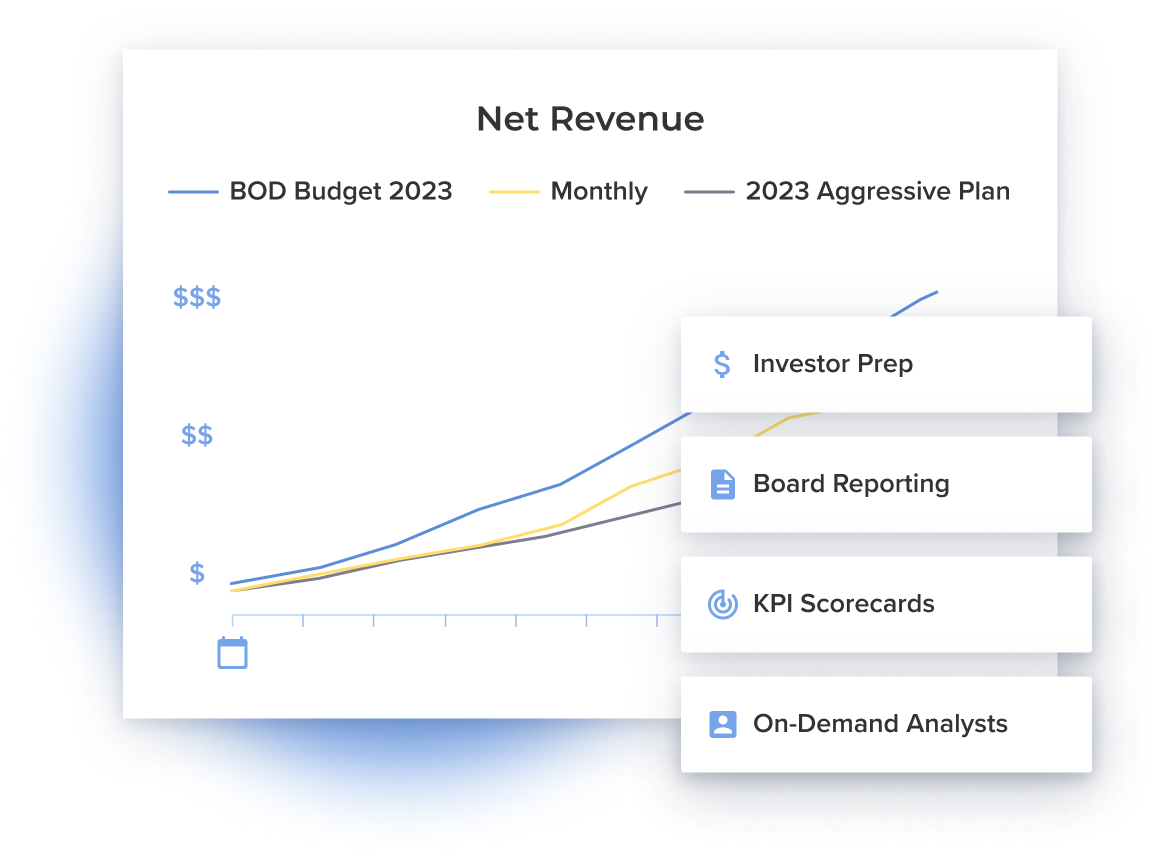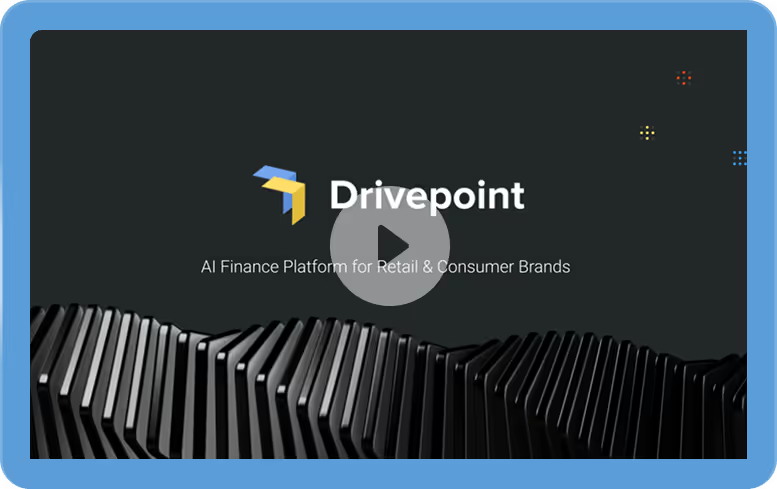How to Measure Business Success with Better Metrics: An Expert Guide

.png)
Leaders in the trenches often fall into the trap of tracking business performance with the wrong measurements.
It makes sense that CEOs would ignore some data. They just need the bottom line to acute questions like, “Can we cover our short-term costs/liabilities this month?” and “What’s our cash position across entities right now?”
The problem, though, is that without the nuance, you lose visibility into what drives the cash flow — leading to uncertainty about which levers to pull to increase revenue.
Here to help is Mark Ellis, a finance and HR executive with a background in retail, manufacturing, and eCommerce. Mark says that the most obvious business performance metrics can be irrelevant — or even misleading — when viewed alone. Like the gauges on a vehicle’s dash display, leaders must view multiple measurements within the context of one another to truly measure business performance.
Identify common vanity metrics
Today, the term vanity has negative connotations, but the original word simply means empty. Imagine a trusted analyst handing you crucial reports just before a key decision or meeting — and all the fields are empty.
Some vanity metrics include:
- Current cash in the bank (without considering the next 13 weeks)
- Revenue (without accounting for costs or profit margins)
- Team productivity (without measuring business outcomes)
- Sales and growth metrics (without considering acquisition costs, long-term customer value, or retention)
- Social media follower count (without analyzing engagement or any conversion intent)
Today’s tools and best practices have evolved. You no longer have to tolerate one-sided, outdated, or otherwise empty metrics.
Why smart leaders focus on overt — yet unhelpful — performance indicators
Mark, an experienced business-builder himself, understands the fixation on business’s most basic numbers. He was the CFO at Amika Haircare, DevaCurl, and Babyganics through high-growth and successful acquisitions, and he served as VP of Finance at a division of Chanel. He says that by default, leaders grab hold of easy-to-measure data points that only show one side of a company’s health at a time.
"They're thinking, 'I just want to make sure my bills are paid. Do I have enough cash?'” he says. “From there, they're using their instincts to figure out what's selling, how they can promote more, and how they can encourage a customer to buy more."
This narrow view creates hazards and causes leaders to miss opportunities. Knowing why leaders gravitate toward this pitfall makes you more likely to see the signs early on in your own thinking and course-correct.
Leaders’ role rarely involves crunching numbers
Founders and CEOs need to cast vision, galvanize, solve problems, and use creativity to manage risk. Finance is traditionally thought to support this work, not co-lead the charge.
This mindset led to many leaders relying on the most talked-about metrics, like those listed above — and executives rarely have time to change that. Innovative founders also tend to appreciate bottom-line answers and have little desire to dig into all the nuance available.
In short, CEOs need to be “just aware” enough to make the best decisions — and no more. “But what they don't realize is that without visibility, they’ll get into a position where cash is running out, and they don’t know why,” says Mark.
The good news? With the right finance tools, founders and CEOs don’t need to change their roles or personalities to be more informed.
Unawareness of tech capabilities
eCommerce leaders have more data than ever before to inform smarter decisions. But yesterday’s data collection and analysis tools don’t deliver the depth and breadth of insights they need to win in today’s quickly evolving markets.
According to Mark, the right eCommerce solutions can capture valuable information generated by brand (and customer) activities. Then, they can deliver the data in a more usable package. “A lot of customers will supply you data,” Mark says. “Modern technology takes it and puts it in a format that people can easily understand.”
Take the undercelebrated example of automation — a tech capability many leaders are just now beginning to grasp. eCommerce automation capabilities can show customers’ product searches, browsing behavior (down to scroll speed, mouse movement, and heat mapping), abandoned carts, and purchase history. Meanwhile, brick-and-mortar stores are still limited to POS data.
While keeping up with new tech can seem overwhelming at first, it's a rich opportunity to get more traction from all your activities.
Missing context
Even with newer tools, relationships between data sets are fragmented. Causal and correlated events aren’t connected because each tool houses separate data sets meant to serve a single purpose. No conclusions are explicitly drawn, so decisions are based on incomplete information.
“If you can calculate relationships between data sets quickly, then you can make sure the resulting totals make sense,” Mark says. “From there, you can spot anomalies and determine what caused the outlier. Say you offered huge discounts to certain people — you can extract that and run the report again.”
The trick, Mark says, is having a system like Drivepoint to centralize your data, making all that context readily available.
Adopt metrics that help you sidestep trouble and pursue opportunities
No leader would say their North Star is somewhere in the past. But the past is what guides them when traditional monthly statements are all they use to get their bearings.
“A lot of accounting involves recording what happened,” says Mark. “But financially, you always want to be thinking about what will happen in the next 6 to 12 months.”
When you optimize the right metrics, you can get a holistic view of how operations impact finances and vice versa. The following performance indicators can illuminate a 360-view of your business, including potential scenarios that could emerge.
These metrics are not “better” in and of themselves — but together, they create a complete picture of your financial health.
Contribution margin
Contribution margin means net revenue after adjusting for variable costs involved in the sale of a product. Often, leaders use it within the context of revenue by creating a contribution margin ratio. The formula is simple: (Revenue - Variable Costs) ÷ Revenue.
Contribution margin is more granular than net margin when combined with the right metrics. While net margin lumps all costs together, contribution margin accounts for variable costs and fixed costs separately.
“Try to view contribution margin by customer or another category,” Mark advises. “I especially love to look at this metric by channel. That visibility reveals whether you’re spending more than you prefer on marketing and sales in a particular channel.”
LTV, CAC, AOV, repeat purchases, discount rate
Lifetime value (LTV) is the total revenue generated by a customer’s business from their first to their final sale. For a one-time customer, that’s the value of a single transaction. For loyal repeat customers, it’s the sum value of a series of repeat transactions.
Customer acquisition costs (CAC) are the outflows required to attract and retain customers. This figure may fluctuate through growth phases, seasonal campaigns, talent management changes, and more.
Average order value (AOV) is the average revenue generated by a customer per order. Do they tend to buy a variety of products or a handful of the same items at once, or do they make smaller purchases more often? Are they inclined to make impulse additions to their cart or stick with what they came for that day?
These metrics are often found together in performance reports from eCommerce platforms like Shopify and BigCommerce.
When combined with financial inputs (like costs and short-term liabilities), LTV, CAC, and AOV metrics widen a business leader’s visibility.
Mark says this wider lens can inspire ideas to generate more qualified leads, potentially increasing LTV. “It's always about looking forward,” he says. “These metrics can tell you when to discount, what trends impact other trends, and how new customer behavior compares to that of enduring customers over time.”
Inventory turnover and sell-through
While sell-through indicates how much inventory has sold, inventory turnover reveals the pace at which those sales occur. Your sell-through rate provides insights that guide storage, inventory management, sales strategies, and merchandising decisions.
These metrics help a business leader’s visibility by equipping them to spot waste reduction opportunities and circumvent stockouts, which put sales and customer experience at risk.
“Looking at these numbers over time answers questions like, ‘How many packages am I shipping each week? What's my cost? Am I running in line? Am I shipping more than I thought or fewer?’” Mark says. “It's about building great data and using it to inform decisions.”
Gross profit by SKU, customer, and channel
Gross profit viewed by variables helps visibility by uncovering otherwise unconventional wisdom. Imagine you see a low-profit customer group creating strategic value for new market entry — without the context, you might have dismissed a high-value segment.
“Try to look at gross profit down to the SKU level,” Mark says. “You may find you’re focused on selling something that doesn't make you as much money as you thought.”
From there, Mark suggests applying the same exercise to individual customers or customer groups, then moving on to sales channels.
Look beyond the post-mortem financial analysis
Accounting is the rear-view mirror in a vehicle, while strategic finance is a dash full of helpful displays. The displays tell you how fast you’re going, what fuel is available, what gears you have, and what steering options you have to change course. When you view high-quality, multifaceted data in context with other metrics, you see beyond the rear-view mirror and use what you observe to navigate to exactly where you want to go.
Understand what’s generating revenue
Identify and either bolster or replicate the initiatives and products that have met or exceeded expectations.
A big-picture view equips you to adjust pricing, optimize inventory lead times, and run accurate demand planning scenarios. “If you know what you're going to sell, you have a clear idea of how to plan for demand,” says Mark. “And that's one of your biggest expenses — overshooting or underestimating what you'll buy and the inventory you'll hold. It’s hard to get it right without the correct metrics.”
Take inspiration from successful retailers like Abercrombie & Fitch, whose new and experimental wedding attire and NFL apparel lines outperformed projections, prompting the brand to celebrate, prioritize, and expand on those products. A&F’s leaders aren’t operating with blinders, though — they know higher freight costs could antagonize these gains, so they plan to make moves to mitigate that risk.
Make faster and more reliable data-driven decisions
AON’s 2024 Business Decision Maker Survey revealed that 72% of business decision-makers feel their organizations can’t move fast enough. The same report found that more confident leaders called out comprehensive data and analytics as the key to moving quickly in the face of risks and opportunities.
“You can't have financials that come out 20 or 30 days after the end of the month — by then, you've already operated through the next month,” he says. “Instead, you need data out in 6 or 7 days. With a system like Drivepoint that links into your ERP system, it’s so much easier for people to produce actionable data.” And that, he says, is critical for effective decision-making.
Consider once again the increasing logistics costs that threaten Abercrombie & Fitch’s recent wins. The brand has experienced supply chain disruptions and resulting cost spikes before — and with the right metrics, they can address the challenge confidently.
Drive growth and value for better ROI on initiatives
Mark emphasizes that business-building success is about putting great products first.
“I've built and grown a number of big businesses, and one went from 40 million to 400 million,” recalls Mark. “But if leaders don't understand what's generating the money, uninformed decisions can threaten all the gains.”
Only 17% of businesses have achieved data mastery — but those who have drive value and better ROI on their business activities. Data master outliers report a 39% higher net income margin than all other companies and 42% higher net income growth in the past three years.
Drivepoint gives brands visibility to see around corners and into the future
Understanding the relationship between spending and profits unlocks your own brilliant ideas about how and where to invest the company’s money. The trick is to balance granular data with the big-picture, bottom-line numbers that your CEO is eager to see.
So what’s an executive to do? Dive into bank statements and accounts receivables for those tiny details? No.
Upgrade your tools and processes to surface only the most relevant business metrics. Drivepoint combines reliable hindsight with innovative, always-evolving foresight to make better decisions. The strategic finance platform has the trust of scaling consumer brands like Immi, Earth Breeze, and Dose.
Drivepoint’s zoom-out and drill-down capabilities help CPG brands grow by providing intelligent context for fewer unknowns:
- Financial reporting engine out of the box
- Automated insights that cut manual data collection and work with Excel
- Sell-through data on Amazon incorporated into ERP and financial systems tools
Get unbiased insights at the macro level faster, then use advanced scenario modeling and forecasting to unlock sustainable, long-term growth.
Schedule a personalized demo today to see the tool in action and get a glimpse into your organization’s future.
Subscribe to our newsletter

Ready to see what you can do with Drivepoint?
Learn how other consumer and CPG brands are driving margin and cashflow with Drivepoint








